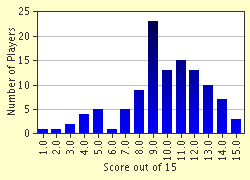Quiz Answer Key and Fun Facts
1. What were the names of Paul and Chani's children in "Children of Dune"?
2. What was the name of the totally paved over planet in Isaac Asimov's "Foundation" trilogy?
3. In "Demon With A Glass Hand", a Harlan Ellison story, what was so special about the android's glass appendage?
4. What film are the words "Klaatu Barada Nikto" from?
5. What was the main premise of the Arthur C. Clarke novel "Fountains of Paradise"?
6. What was so odd about the two separate novels, "Childhood's End" by Arthur C. Clarke and "The Midwich Cuckoos" by John Wyndham?
7. What is the name of the fellow who Paul angers after socking him in the jaw midway through "Dune", as Paul and Jessica encounter the Fremen?
8. What anthropomorphic device was shaped like a mouse in "The Martian Chronicles"?
9. What did firemen actually do in the Bradbury story "Fahrenheit 451"?
10. In the "Star Trek: TNG" novel "Gulliver's Fugitives", which has a similar theme to "Fahrenheit 451", what is the name of the blind, female fellow engineer who works with La Forge to jury-rig an enemy probe to actually spy for them?
11. In "Rendezvous With Rama", what did the "inhabitants" of Rama resemble?
12. What are the names of the two races living thousands of years in the future that the time traveler encounters in H.G. Wells' "The Time Machine"?
13. Isaac Asimov got his start writing pulp fiction.
14. Who or what could be considered the main character of Isaac Asimov's "The Last Question"?
15. What is the answer to the ultimate question...("The meaning of all life and existence") in the comedy science fiction novel/radio-TV series/movie, "A Hitchhiker's Guide To The Galaxy"?
Source: Author
photoscribe
This quiz was reviewed by FunTrivia editor
agony before going online.
Any errors found in FunTrivia content are routinely corrected through our feedback system.

